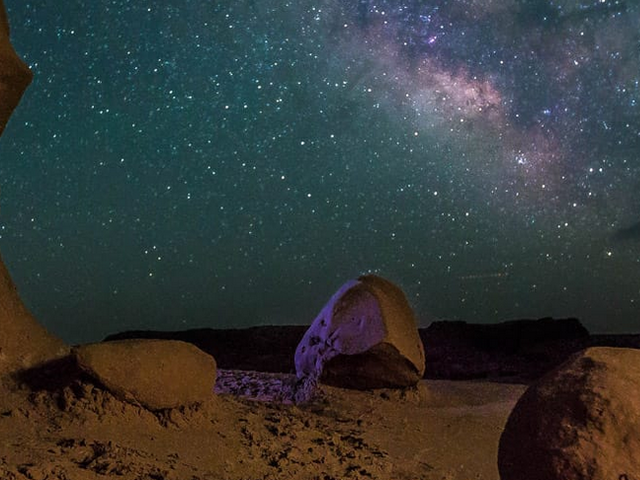
We often think of our travels as an 'escape' - have you thought of them as an escape from ... light? Or do you simply love gazing up into the mysteries of the universe, in a clear, clear night sky, unpolluted by man-made lighting? Utah is one of the best places for avid stargazers to celebrate International Dark Sky Week 2017, April 22-28th.
The state is home to seven of the world’s 42 International Dark Sky Parks as well as Natural Bridges National Monument, the world’s first International Dark Sky Park, as certified by the International Dark Sky Association (IDA) . A Dark Sky Park is an area defined by the IDA where the night sky can be viewed clearly without any "light pollution.”
Southern Utah offers remote areas where 15,000 or more stars are visible in the night-sky (astronomers believe people who live in urban areas can see fewer than 500 stars). During International Dark Sky Week 2017 and throughout the year, visitors to these Utah Dark Sky Parks offer outstanding quality night skies:
- Canyonlands National Park is known for its dramatic desert landscape carved by the Colorado River.During the spring and fall, Park rangers offer programming on a rotating basis with other Parks with the ultimate goal being to introduce visitors to the wonders of the night sky. Stargazing and telescope viewing follow ranger programming
- Dead Horse Point State Park: This Park has partnered with Canyonlands National Park to host dark-skies programming. This state park overlooks the Colorado River and Canyonlands National Park, covering 5,362 acres of high desert at an altitude of 5,900 feet. Even if you've never been, you've probably seen it already; it was used in the iconic final ‘Grand Canyon’ scene of the film Thelma & Louise
- Capitol Reef National Park: This Park has some of the best night sky viewing opportunities of the western national parks. The park is famous for its layers of golden sandstone, canyons and striking rock formations, including Chimney Rock pillar, the Hickman Bridge arch, and Capitol Reef white sandstone domes, and the towering monoliths of Cathedral Valley. Past summer stargazing programs have included Night Sky Tours by visiting astronomers
- Goblin Valley State Park: In addition to its claim to fame (and name), its thousands of hoodoos and hoodoo rocks, referred to locally as "goblins", which are formations of mushroom-shaped rock pinnacles, some as high as several meters, the National Park Service’s Night Sky Team determined this park to have some of the darkest night skies on Earth.
 Here you'll find unparalleled views of the Milky Way. Visitors can experience a variety of ranger-led monthly moonlit hikes and telescope tours
Here you'll find unparalleled views of the Milky Way. Visitors can experience a variety of ranger-led monthly moonlit hikes and telescope tours - Hovenweep National Monument: Until recently best-known for the six groups of ancestral Puebloan villages, there is evidence of occupation from 8,000 to 6,000 B.C. The Monument’s night sky remains about as dark as it was 800 years ago due to its geographic isolation. The Monument’s Rangers offer visitors stargazing programs throughout spring and summer so you can literally see the stars like North America's first peoples did.
- Natural Bridges National Monument: Named for its primary feature, the thirteenth largest natural bridge in the world, carved from the white sandstone, the park was designated the world's first dark-sky park in 2006. Here you can gaze at the very same stars the ancestral Pueblo people observed 800 years ago. Park rangers will offer astronomy programs beginning May 2017
- Weber County North Fork Park: Unlike the majority of International Dark Sky Parks, North Fork Park sets itself apart from the others because of its adjacency to urban areas and its innovative public art incorporating dark skies themes.
The International Dark-Sky Association (IDA) is a United States-based non-profit organization incorporated in 1988 by founders David Crawford, a professional astronomer, and Tim Hunter, a physician/amateur astronomer. The mission of the IDA is "to preserve and protect the night time environment and our heritage of dark skies through quality outdoor lighting". To promote awareness about the issues about the disappearing darkness in the world and its effect on human and wildlife wellness, the IDA has an International Dark Sky Places program that aims "to protect locations of exceptional nighttime visages for future generations". Since 2006, it has been designating International Dark-Sky Parks, International Dark-Sky Reserves, and even International Dark-Sky Communities for star gazers and our global natural heritage.
Start your Trip!
Copyright BestTrip.TV/Influence Entertainment Group Inc or Rights Holder. All rights reserved. You are welcome to share this material from this page, but it may not be published, broadcast, rewritten or redistributed.
Start your trip to Utah
Let us help you plan your trip
Start your trip to Utah
Let us help you plan your trip
Featured Experiences
Seabourn Announces 2025-26 Expedition Cruises, with 20% Savings on Greenland - Alaska Sailings
Seabourn has unveiled its ultra-luxury expedition cruise ... more
G Adventures Goes Luxe
G Adventures has launched a new style of upscale, active ... more
Adventures by Disney: Family River Cruising Returns to Europe in 2024
Adventures by Disney is returning to three of Europe'... more
Save on a Collette Tour to South Africa, Offering the Best of Culture and Wildlife
Collette’s tours to South Africa allow travelers to explo... more
Popular Posts
- 8 Facts About the Panama Canal
- 10 Amazing Facts about the Tasmanian Devil
- Top 6 Wellness and Fitness Cruises You Should be Booking Now
- Where's the Only Restaurant in Alaska by a Michelin Starred Chef?
- Top 10 Reasons to Travel to Croatia
- Discover Tropical Romance in 3 Overwater Bungalow Resorts on the Caribbean Sea




